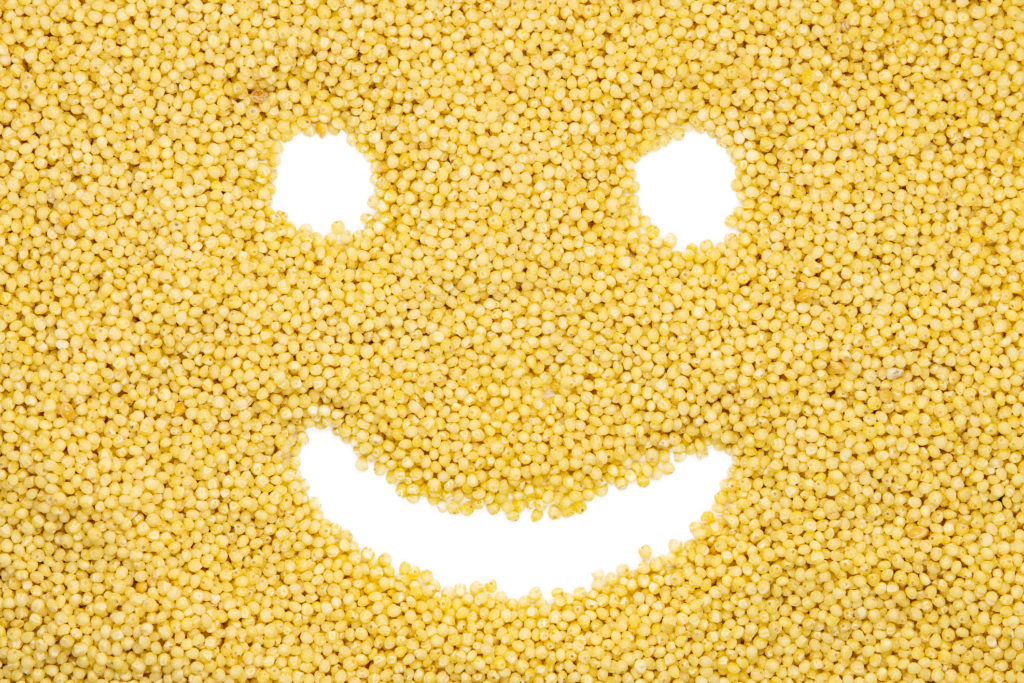
6 reasons you should be eating millet
Millet is one of the most affordable and nutritious grains around, and yet it’s one of the least popular in the UK. You might dismiss millet as “bird food,” but it’s actually great for human consumption.
As one of the oldest cultivated grains, millet has been a dietary staple for thousands of years across South-East Asia and Africa. Millet’s popularity is increasing in the UK because of its rich nutrient profile1https://www.webmd.com/diet/health-benefits-millet Read on to find out what all the hype is about!
What is millet?
Millets are a group of gluten-free cereal grains, similar in size to seeds. Millet belongs to the grass family and come in many forms, large and small. Pearl millet is the most popular for human consumption – but all types of millet boast a powerful nutrient profile.
What are the health benefits?
Research into the health benefits of millet is ongoing, but here is what we know so far:
- Supports gut health – millet is rich in fibre, which is crucial for your gut health. Fibre aids gastrointestinal motility and may help reduce your risk of constipation and diarrhoea.2https://www.ncbi.nlm.nih.gov/pmc/articles/PMC4033754/
- Lowers blood sugar – the glycaemic index (GI) rates foods by how fast they affect your blood sugar levels. Millet is low on the GI scale – it releases energy slowly into your body, providing you with longer-lasting energy and reducing your risk of blood sugar spikes.3https://www.ncbi.nlm.nih.gov/pmc/articles/PMC4033754/4https://nutritiondata.self.com/facts/cereal-grains-and-pasta/5702/2
- Aids weight loss – millet is rich in protein and protein increases satiety, which can be beneficial for supporting weight loss. Protein is also important for growth, development, and cell repair throughout your body.
- May help bone health – Millet contains more calcium than other cereal grains. Calcium is crucial for bone health.5http://www.jsirjournal.com/Vol5_Issue2_04.pdf
- Helps lower cholesterol – Millet is rich in soluble fibre, which can help reduce your cholesterol and reduce your risk of heart disease.6https://www.mayoclinic.org/diseases-conditions/high-blood-cholesterol/in-depth/cholesterol/art-20045192
- Rich in antioxidants – Millet contains high levels of phenols, a type of antioxidant which helps prevent oxidative stress in the body.7https://www.ncbi.nlm.nih.gov/pmc/articles/PMC4033754/
What is the nutrient breakdown?
Millet is rich in a range of nutrients. 100g of cooked millet will provide you with8https://nutritiondata.self.com/facts/cereal-grains-and-pasta/5702/2 –
- Energy – 119kcal
- Carbohydrate – 23.7g
- Fibre – 1.3g – 5% of your daily recommended intake (30g)
- Protein – 3.5g
- Fat – 1g
… as well as a range of vitamins and minerals such as calcium, magnesium, phosphorous, folate, iron and B vitamins.9https://nutritiondata.self.com/facts/cereal-grains-and-pasta/5702/2 The nutrient profile will naturally vary between types of millets.
However…
Millet does contain phytic acid, an antinutrient that can bind to key vitamins and minerals, hindering their absorption.10https://www.ncbi.nlm.nih.gov/pmc/articles/PMC5983567/ To lower the antinutrient profile, soak in water overnight, drain and rinse well before using.
How do I prepare millet – and where do I find it?
Millet is versatile and can be eaten sweet (think porridge, topped with berries) or savoury, such as in place of rice. Depending on how you cook it, you can end up with a creamy texture much like mashed potato, or a crunchier texture like rice or quinoa!
To cook, add 1 cup to a dry saucepan and toast for a few minutes until the millet turns golden brown. Add 2 cups of water or stock to the pan and bring the mixture to a boil. Lower the heat and simmer until almost all the liquid is absorbed, this will take approximately 15 minutes. Remove from the heat and let stand for 5-10 minutes for the remaining liquid to be absorbed. Fluff and serve!
Why not try millet pilaf with vegetables, millet & courgette fritters or millet porridge with berry compote.
To find out more about our other favourite grains here at CG, check out these posts – oats, buckwheat and quinoa and amaranth.
Feel free to get in touch with our Nutritional Therapists via live chat 8am to 8pm weekdays to have your questions answered!
References
- 1
- 2
- 3
- 4
- 5
- 6
- 7
- 8
- 9
- 10
















